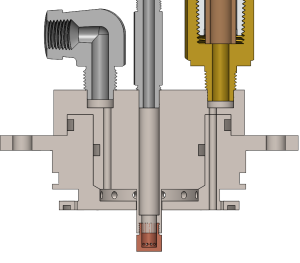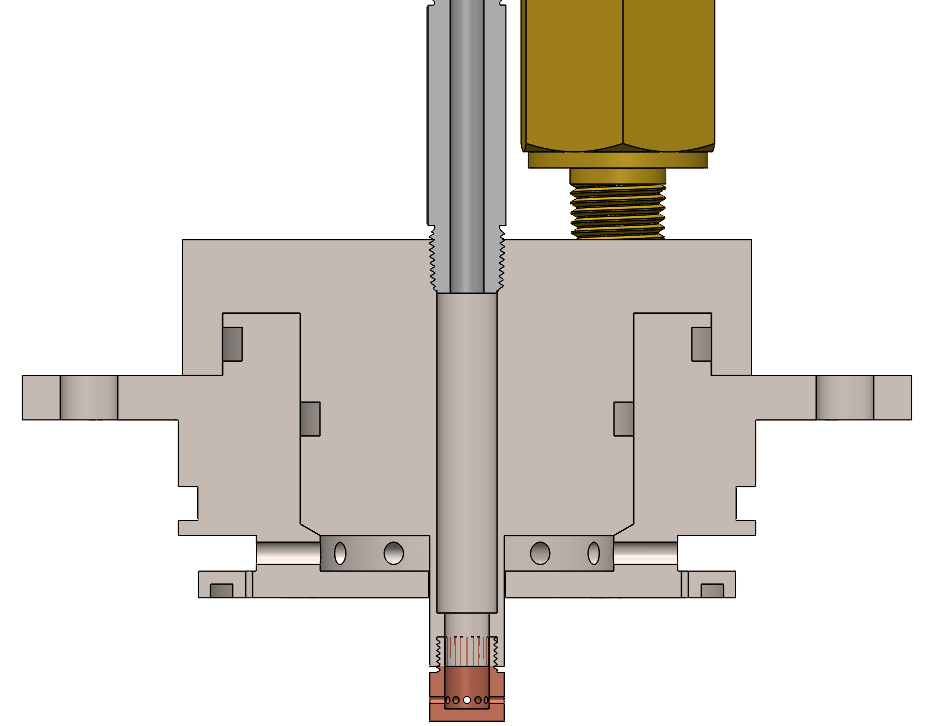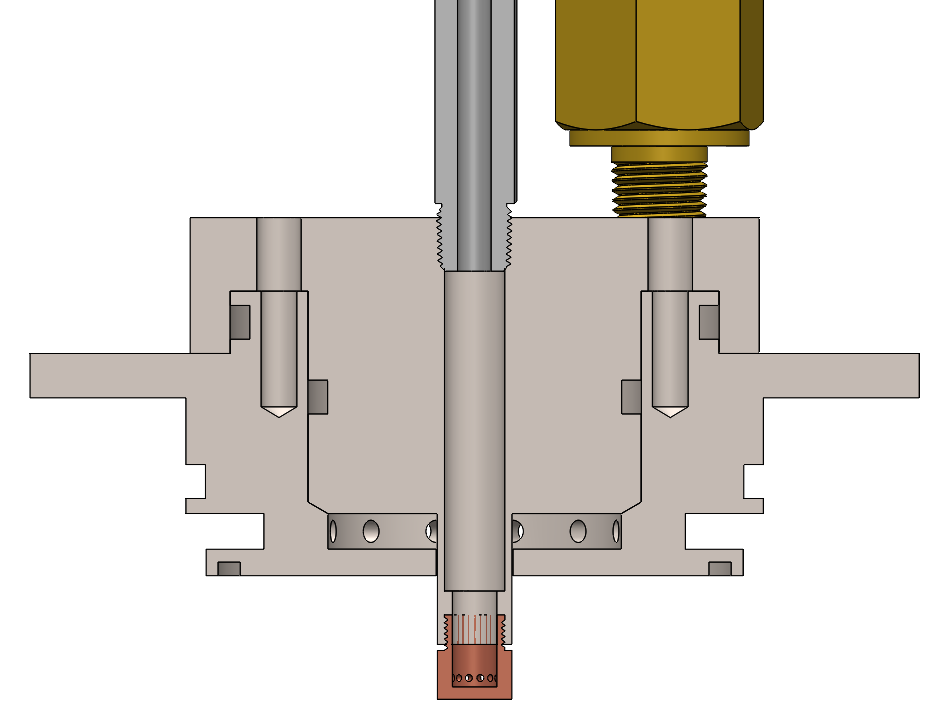...
One of the main challenges with using a pintle injector for a nitrous-ethanol ipa combo is spray angle. A lower spray angle is desirable because it means the mixed propellant has to travel further to reach the wall, and so can disperse more. However, when using nitrous-ethanol ipa as propellants, a high mixture ratio is often used. This means that the nitrous will have a lot more momentum than the ethanolipa, and since the pintle is ox-centered (there is basically no way to manifold the regen cooling to the center of the injector to have it be fuel centered) the spray angle will be exceedingly high. However, we intend on drilling the pintle holes at an angle to enforce a lower spray angle.
This is the current iteration of the pintle injector, with some dimensions (i.e. number of film cooling holes or number of flange bolts) not calculated yet. Also, the nitrous orifices are not angled yet. However, the final design will most likely closely resemble this, as it is machinable and contains no interpropellant seals.
The pintle center body/ tip is made out of copper, while the baseplate is and centerbody are made out of steel. The interruption in the manifold is so igniter/PT ports can connect to the chamber offset from the holes. As of now, this injector stiffness is still (barely) above 15% for 25% throttle. We haven't accounted for pressure loss in the regen channels yet, but since the fuel and oxidizer will be in separate tanks, the fuel pressure is not reliant on the ox pressure; we can increase the tank fuel pressure to account for the pressure loss in the channels if the fuel turns out to have the limiting stiffness.
Lessons learned from previous iterations:
- Radial holes in the baseplate are actually good because they reduce the flow velocity into the annulus. Just make the total area of the holes ~4 times the area of the annulus to make the velocity lowest.
- The pintle should usually be tapered and also sit on a tapered baseplate so that it's centered. If it isn't resting on a slanted surface, then the flange bolts will wobble, which will cause the pintle to translate left and right slightly, which will ruin your annular gap flow.
- Make the tip out of copper and the rest out of steel or aluminum if you think it'll survive so that if the tip gets scorched slightly after a burn you won't have to make the whole center body again.
- For injector face materials with low thermal conductivity like steel, a good practice is to regeneratively cool the face exposed to the combustion chamber gases, which can only be done if that thickness is very low. However, since this engine is operating at a mixture ratio far from stoichiometric, and since the pintle will create recirculation regions below the face, I've chosen to not make the thickness of that part low. The thickness will ultimately be determined by running FEA.
Questions for future iterations:
...
- In pintle injector design, the reason why there's a taper in the centerbody is so it can sit against a similar taper on the baseplate. Since the bolts connecting the centerbody to the baseplate are axial, the centerbody can translate horizontally when the engine is running due to vibrations. Although this may seem counterintuitive because the centerbody sits between two walls in the baseplate, remember that these walls aren't touching as there needs to be a diameteral clearance for the O-ring. Having a taper, however, eliminates this issue.
- If you're concerned about angle tolerances here, know that angularity doesn't matter so long as it's close enough. Surface runout does, but typically this is a small fraction of the total assembly runout. A taper fit essentially trades a slightly worse runout on the piloting surfaces for much better (0) assembly runout, whereas two cylindrical surfaces with a clearance fit can have a slightly better runout on the surfaces but the clearance on assembly creates a significant assembly runout. At the end of the day the concentricity error won't be such a big deal but considering a tapered fit is much more tolerant to assembly runout without being that much harder to make, and that pintles already suffer from flow maldistribution without even considering concentricity, it's probably the way to go.
- If using a taper-taper design, however, it is discouraged to use face seals for the centerbody-baseplate connection. It is unlikely that you can tolerance the part well enough to have sufficient O-ring compression and full contact with the tapers. We had this issue previously, and fixed it by making all seals between the baseplate and centerbody radial seals.
Questions for future iterations:
...
- What angle should the nitrous holes be at to get a good momentum ratio? What even is a good momentum ratio?
- How easy will it be to drill those angled holes? What is the smallest drill bit we could use for that?
- What is the optimal skip length (distance from annulus exit to pintle tip exit)/a rule of thumb for the skip length? How will we enforce that length if we're screwing the pintle tip in?
- For some pintles, I've seen the bottom face of the baseplate be slanted – is there any advantage to this? Perhaps if the taper is parallel to the spray angle it will prevent hotspot accumulation on the sides?
- Does combustion happen right at the face of the pintle tip, where the two fluids collide? If it does, is it a concern?
- How will pressure of the nitrous manifold be measured?



